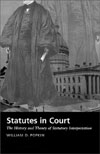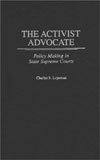March 01, 2001
Wisconsin Lawyer March 2001: Book Reviews
Statutes in Court: The History and Theory of
Statutory Interpretation
 By
William D. Popkin (Durham, NC: Duke University Press, 1999).
340 pgs. $54.95.
By
William D. Popkin (Durham, NC: Duke University Press, 1999).
340 pgs. $54.95.
Reviewed by Jack Stark
In this book, William Popkin intrepidly analyzes the topics that his
title identifies. The first is enormous, and the second is
intellectually complex. Aside from a brief look at early English
statutory interpretation practices, his history is of those practices in
this country. He deals with the major theories as they appear in his
historical section and includes a chapter that explicates his own
theory.
Popkin sets himself an impossible task in the historical section, due
to the huge number of relevant cases. He discusses some that he
considers representative; avoiding detours into such subjects as
constitutional interpretation and judges' political activities would
have allowed him more space for his main topic. Some of his narrative is
skewed by an apparent attempt to discredit textualists: judges and
commentators who would limit interpretation as tightly as possible to
literal readings of statutes.
Popkin advocates "ordinary judging," which is adhering faithfully to
a statute's text and then placing the statute in its temporal context:
determining its meaning in part by its relation to relevant statutes
that were in effect when it was enacted and its relation to facts that
appeared after its enactment and could not have been foreseen. His
subtle treatment of the latter task is the book's strongest section. The
former task is both too broad (it allows distortion of meaning) and too
narrow (if a drafter ignored existing statutes, he or she made a
drafting error, and I would instead allow moving beyond a literal
reading in order to correct obvious drafting errors).
In short, Popkin has not performed the impossible by writing a
complete history of statutory interpretation in this country, although
he has written a prolegomenon to any future such history, and he has
propounded a theory of statutory interpretation that almost convinces. I
also would assert that judges and commentators on statutory
interpretation ought to learn as much as possible about how legislative
drafters conduct their extremely difficult art. In short, this is a
useful book, but more work needs to be done.
The Activist Advocate: Policy Making in State
Supreme Courts
 By
Charles S. Lopeman (Westport, CT: Praeger Publishers, 1999).
129 pgs. $55.
By
Charles S. Lopeman (Westport, CT: Praeger Publishers, 1999).
129 pgs. $55.
Reviewed by Bruce P. Bower
This work may be more of interest to nonlawyers than to lawyers. The
author's intent appears to be: Determine why the supreme courts of
Indiana, West Virginia, and Ohio in the last quarter of the 20th century
fit a definition of "activism." Lopeman defines the term as: "A court is
activist when its decisions conflict those of other political policy
makers [including predecessor courts]."
Although the preface mentions independent interpretation of state
constitutions, the book does not treat that topic very extensively. (The
work has only 129 pages; thus, it is helpful to read the cited cases to
fully understand the author's contentions.) The preface also mentions
"devolution," but the book has more discussion of common law development
than of power shifting from the federal to the state sovereign.
The author identifies examples of activist decisions (as he defines
them) by the supreme courts of Indiana, West Virginia, and Ohio in the
1970s and 1980s. Lopeman then sets about determining why the courts came
to fit the "activist" definition. He concludes that neither the presence
nor absence of an intermediate appellate court, nor partisan divisions
on supreme courts, nor ideology can explain why the three high courts
rendered "activist" decisions. Rather, he concludes that each of the
high courts "had a justice who ... was an advocate of judicial policy
making."
This is an interesting concept. It implies that one justice who is
interested in "policy making" can overcome the disinclination in that
regard of the other justices. Toward its conclusion, the author
discusses how the supreme courts of Idaho, Florida, and Pennsylvania
eschewed opportunities to be activist. Lopeman posits that these courts
did not have an "activist advocate" during the latter part of the 20th
century.
With regard to those courts which the author contends harbored an
"activist advocate," not all would agree with the author's conclusions.
For instance, Randall Shepard was the "activist advocate" on the Indiana
Supreme Court. Yet he merely concurred in the court's opinion in a main
case Lopeman cites, Citizens Action Coalition of Indiana Inc. v. City of
Gary, Indiana, 485 N.E.2d 610 (Ind. 1985). Moreover, that case
interpreted a state statute dealing with amortization of "sunk costs" of
a canceled nuclear power plant. It would seem that if the state supreme
court had been unduly "activist" in interpreting a state statute, the
legislature would have passed a new law, correcting the state supreme
court. That does not appear to have occurred.
One of the main cases cited for West Virginia, Hodge v. Ginsberg, 303
S.E.2d 245 (W.Va. 1983), also involved interpretation of a state
statute. In this case, the "activist advocate," Richard Neely,
dissented. There is no indication that the state legislature corrected
the state supreme court, which the legislature could have done if it
felt the court had been out of bounds.
A main case cited for Ohio, Haverlack v. Portage Homes, 442 N.E.2d
749 (Ohio 1982), dealt with sovereign immunity of municipal
corporations. The Ohio Supreme Court noted that the sovereign immunity
of municipal corporations was a court-created doctrine. In abrogating
this court-created immunity, the Ohio Supreme Court stated, "We hold
that the defense of sovereign immunity is not available, in the absence
of a statute providing immunity, to a municipal corporation in an action
for damages alleged to be caused by the negligent operation of a sewage
treatment plant." (The book misspells "Haverlack" - and that is not the
only instance of misspelling.)
Once again, if the Ohio legislature had perceived that the state
supreme court was out of bounds, the legislature could have passed
corrective legislation. The book does not mention if the Ohio
legislature took any such action. Moreover, Haverlack seems a classic
example of the development of common law. There are many who would opine
that the case-by-case development of the common law is a hallmark of
stable Anglo-American self-rule. Many would posit that the common law,
rather than being an activist tool, through the ages, has been a means
of thoughtfully responding to the developing realities of a changing
society.
Even when a court rules that a state statute is unconstitutional, in
the American system of government, the people can in turn overrule the
state supreme court through constitutional amendment. The lack of
instances of the state legislatures overturning common law decisions of
the state supreme courts that are analyzed, and the lack of
constitutional amendments overruling constitution-backed decisions,
indicates that the courts analyzed in this book were not too "activist"
for the particular states.
The author concludes by stating that activist advocacy, when it
prevails among a court, leads the court to make policy, rather than
deferring to a state legislature or to precedent. Once a court follows
the lead of an activist jurist, then the second issue, the book
contends, is what policy will be adopted.
In a country as varied as the United States, it may be impossible to
exhaustively illuminate why some state supreme courts are more likely
than others to "make policy." If one accepts a definition of "activism"
that is very easily triggered, this book is plausible, within the
paradigm it uses. However, there is such a large variety of fact
patterns that may or may not come before high courts, and, of course,
the decision not to decide a case can have practical impact. Thus, even
within its definition, this book could not capture the full extent of
activism or lack of activism among state supreme courts - perhaps no
work could fully accomplish that.
